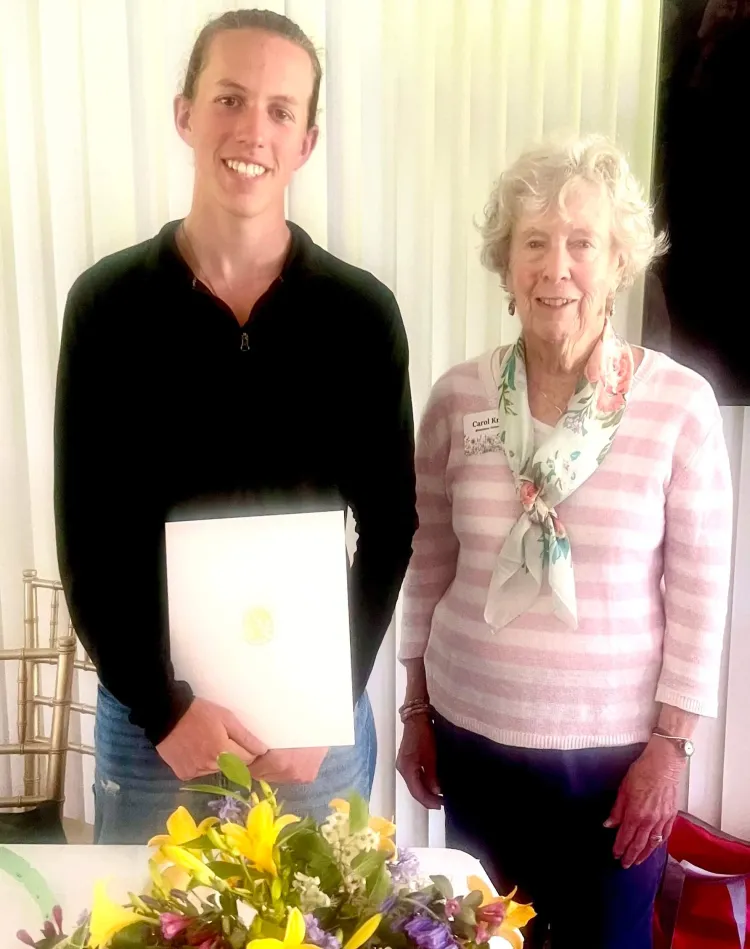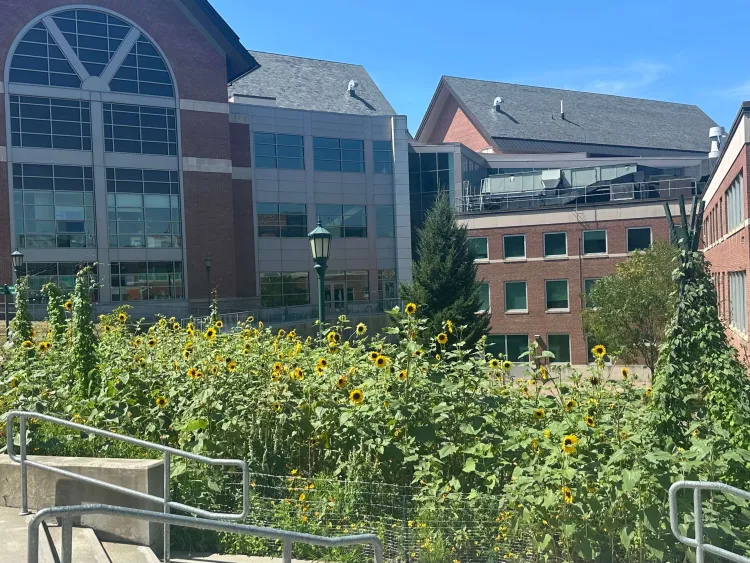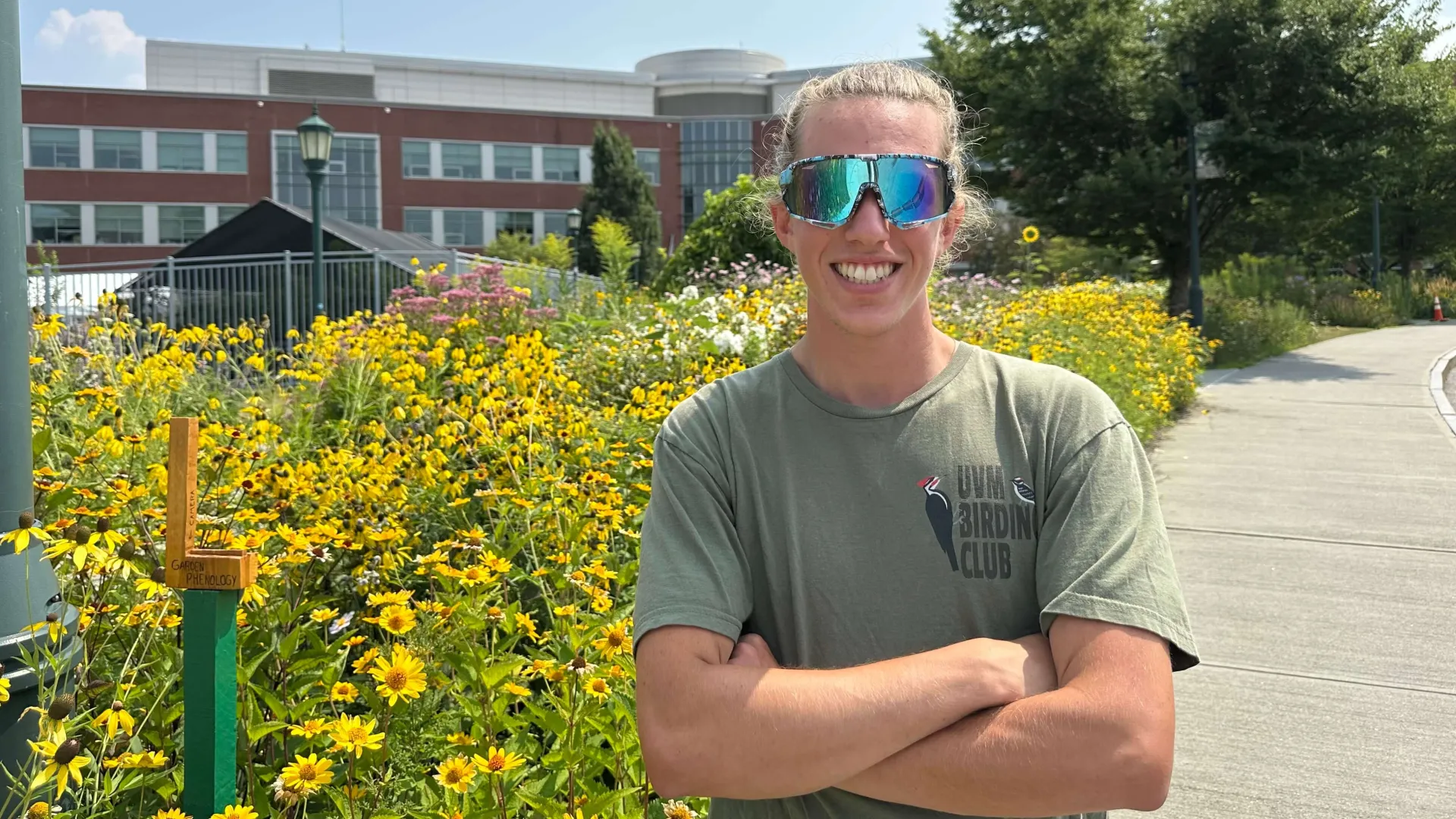Each year, student interns make meaningful contributions to the maintenance and design of those gardens.
Gavin Young ’27, a Rubenstein School student and president of the UVM Horticulture Club, is one of those student interns. He is the 2025 Vermont Winner of the National Garden Clubs Award, and the 2025 Recipient of the Vermont Federated Garden Clubs scholarship. Below is a conversation with Gavin about his work in the UVM Gardens.
What drew you to this opportunity? Had you done work like this in the past?
I've done some horticultural and gardening work; I put an a pollinator garden in at my high school. This is my second year doing the Horticultural internship with Mark (Starrett), and I previously help install the Votey Hall Gardens. So those were a variety of big projects.
It's a great job. I really enjoy the work. I go to bed thinking about the plants, I wake up thinking about the plants. It's a relaxed environment and I'm learning something new every single day about plant care or the insects on the plants, and it's a great opportunity to practice what I think of as urban conservation. I’m combining all these native plants together to emphasize the aesthetic and make it more robust than what you actually see in nature. So that's how being in this garden can be even more exciting than being out in the woods.

What elements of classroom or experiential learning inform your day to day work?
There are snippets from a lot of different classes that I use on a daily basis. I’m a Wildlife and Fisheries Biology major with a minor in Sustainable Horticulture. Wildlife bio isn't directly related to all these horticultural practices, but I still use a lot of my coursework in my internship.
In NR 2030 with Mariano Rodriguez-Cabal and Noelia Barrios-Garcia, I learned how landscapes can either be wildlife sinks or sources. We don't only want to attract pollinators with flowers, tricking them into thinking our campus is habitat, we actually want to manage a healthy ecosystem for them throughout the year. Otherwise, my classroom learning is reflected in the gardens when conserving plants in urban areas and doing some casual insect monitoring.
The campus gardens change hugely throughout the year. Beyond benefitting pollinators, what informs those design decisions?
Garden phenology is something that I'm thinking about a lot. In our case, it can come down to luck and timing, This spring, about 14,000 bulbs were donated to the Horticulture Club. Mark goes out and picks up the bulbs that don't sell at garden and landscaping retailers. Usually, we plant the bulbs in the fall. But if we’re getting them donated in November or January, we can't do that. So, we vernalize them in the coolers and have an activity where students can learn about that process. Then, once spring rolls around students help plant them for some early spring color and pollinator resources.
For these gardens, when we're making plant decisions, we're putting emphasis on spring and fall, because that's when the campus population increases by around 12,000. It’s also good to consider options for season extenders for pollinators. In the middle of summer, there's all sorts of plants which are resources to pollinators available, but in early spring, those crocuses that we put out, those are some of the only flowers that you're seeing. In late fall, if we're planting goldenrod and asters, those are fantastic source of color and the best host plants. Other season extenders like Gem marigolds and Dyers chamomile can bloom up until November 15th, which is great to have.

Are there things that UVM does differently in the gardens with sustainability in mind?
“Leave the leaves and save the stems,” is a popular saying with gardeners. It’s important to incorporate garden initiatives that prioritize native bees that overwinter in pithy stems or butterflies and bumblebees that overwinter in leaf litter. If a modern gardener and a more traditional gardener are butting heads, it’s probably about that.
Last year, I chose two beds and said, all right, we're leaving this stuff so there can be some overwintering habitat for insects. The issue is that during spring, summer, and fall, the campus gardens are a big resource for all this wildlife. But if landscapers are getting rid of everything dead and on the ground during the winter, it’s like they’re restarting the clock for wildlife. The garden becomes a sink, not a source. We need to be able to accept that a messy garden can be the healthiest for pollinators. So that's a fun and challenging struggle. Also, because we're in the middle of Burlington, there are very few natural predators for voles and mice, which can wipe out a third of bulbs that we plant each winter. That's good eating for them.
Do you use any pesticides or herbidices?
No pesticides, no herbicides. We’d have to get special permission to use those. We have had some amaranths that have been failing because of a fungus, which is too bad because they’re Love-Lies-Bleeding amaranths— they're big, and beautiful; they're a good attraction. It's just something that we have had to deal with.
When something like that fungus happens, are you ever able to consult with faculty and researchers about what you’re finding?
Ann Hazelrigg is the UVM plant diagnostician. We gave the amaranth with the fungus to her. She's a great resource for us. It was collapsing at the at the bottom of the stalk, and she told us what fungus it was, and how to avoid it—we have to go light on the watering.

What is that your favorite section of the garden? If you had to pick one thing that you've worked on that you're really proud of, what would it be?
I love designing gardens. So, on Aiken Hillside, there’s a bed we call Top Aiken. We put rebar poles in it with three different types of vines. Horticulture Club had a little extra money this year, and so, we went out and bought perennials and installed an endcap in this garden bed which will emphasize in fall blooms. That little section of the garden is hopefully a showcase for how we can perennialize the rest of Aiken Hillside. Because even though they're beautiful gardens, especially at graduation time with the tulips, putting that much effort into annuals every year is not sustainable money wise or energy wise. So being able to pick out all those plants, different species, deciding how they rise in the back and how they work together, I just love it. I might submit a grant proposal to perennialize more of the Aiken Hillside. I got another grant to put in a soft-landing garden over on central campus. We just ordered bulbs for it today!
In the spring of 2025, Gavin was awarded a Sustainable Campus Fund grant to install a Soft Landing Garden by the Central Campus Residence Hall. The award includes funds for plant material, garden amendments, wages for site prep and maintenance and interpretive signage. Gavin also received an award from the UVM Office of the President's Planetary Health Initiative for an apiary meadow renovation project, which is ongoing.
